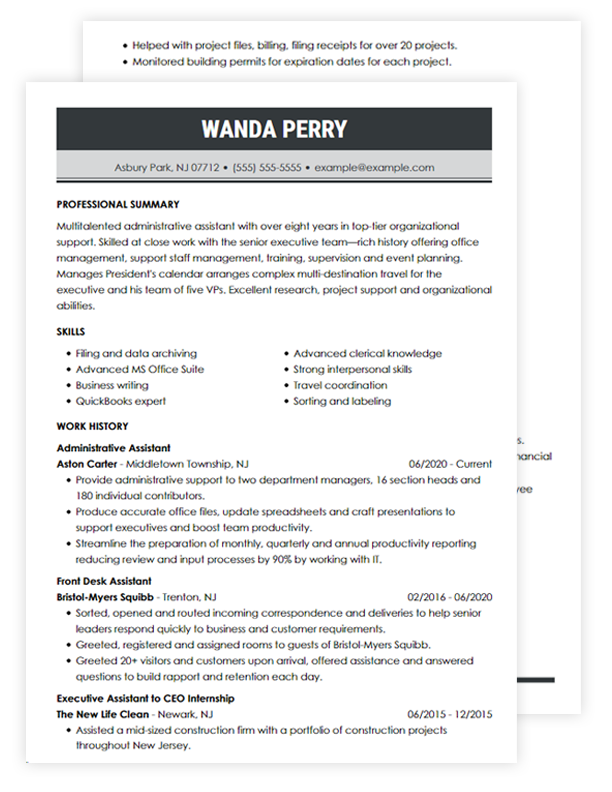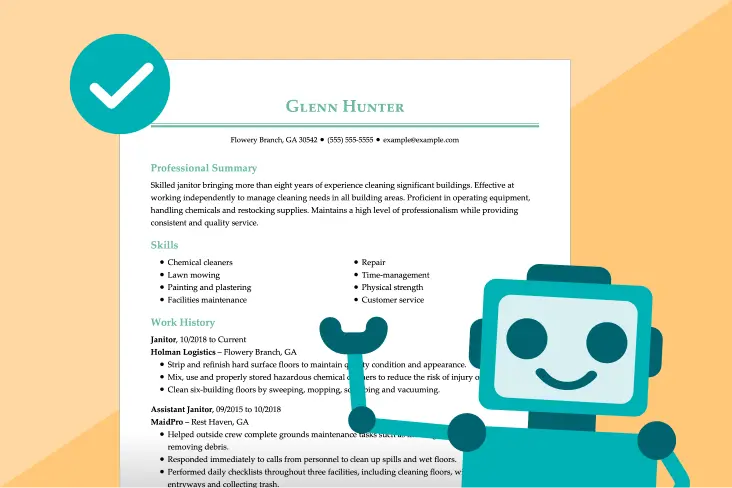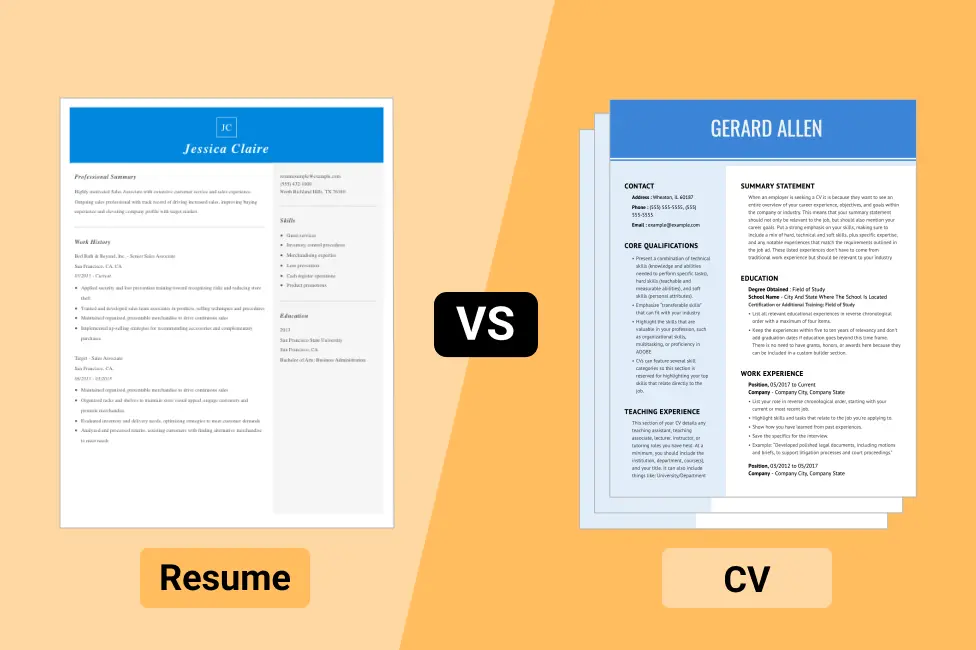Demand for Master of Business Administration (MBA) graduates is at an all-time high. With MBA grads earning an average of $115,000 annually, college graduates and seasoned professionals are returning to school to improve their earnings and career growth.
Applying for an MBA starts with choosing the right program and compiling all the documents you need for the application packet. As certified resume writers, we’re here to help you create a resume for an MBA application that showcases your most relevant skills and experiences to wow recruiters and land you that coveted spot for an MBA.
Before we begin, check out this resume template for an MBA application. Click it to edit your resume in our Resume Builder.
MBA Resume Template
What makes this MBA resume different from a job resume?
Writing a resume for an MBA application will differ from crafting a resume for a job. You need to tailor the MBA resume to the specific program and rely more heavily on your academic experience and achievements that relate directly to the field of study you will focus on. An MBA resume:
- Targets admissions committees and focuses on how the candidate will contribute to the MBA cohort and succeed after graduation.
- Emphasizes leadership skills, initiative and innovative thinking that proves the candidate is ready for the challenge of being in a business school.
- It’s part of a larger application narrative that includes essays and interviews with the admissions committee; therefore, it should be cohesive with the candidate’s personal branding.
- Should showcase the candidate’s career progression and emphasize projects that helped the candidate demonstrate what it means to run a business.
How to Write a Resume for an MBA Application
Before you start writing your MBA resume, ensure you complete the following steps:
Study the MBA program and university’s website to understand their values, mission and what they look for in their ideal candidates — doing so will help you decide on the appropriate resume skills and accomplishments to include in your resume.
Gather key information about your educational background and professional achievements. If it’s been a while since you were in school, take some time to collect the exact dates, grades, coursework and any other details from your past degrees. Do the same for key projects, initiatives and internships from your work history.
Choose an appropriate resume template that’s visually appealing but professional. Ensure your template follows a resume format highlighting your unique strengths, whether that’s a long business career, specialized skills or a little of both.
Now, let’s dive into how to write each section of your resume for an MBA application!
Write a Compelling MBA Resume Objective
Your resume for an MBA application should begin with an objective statement that shares your interest in the MBA program of your choice and how your skills and qualifications will contribute to the university.
Contrary to a job resume summary, the MBA resume objective is more tailored to what you want to accomplish in your studies. Some MBAs focus on leadership and management, others focus on innovation, and others are more closely related to a specific field, such as finance, marketing or technology.
Ensure your MBA resume objective features skills, qualifications and achievements that match the program’s unique requirements.
To help you visualize this section, check out these MBA resume objective statement examples:
Finance
“Results-driven financial analyst with 5+ years of experience in corporate finance, investment strategy and portfolio management. Seeking to leverage strong quantitative skills and leadership experience to contribute to MBA cohort and expand expertise in financial modeling, risk management and global markets. Eager to pursue opportunities in investment banking and private equity post-MBA.”
Marketing
“Creative and data-driven marketing professional with seven years of experience in digital marketing, brand strategy and consumer behavior analysis. Proven track record in driving 25% brand growth through targeted campaigns and social media initiatives. Seeking MBA to deepen strategic marketing knowledge and transition into leadership roles in global marketing and product management.”
Entrepreneurship
“Entrepreneurial business development manager with six years of experience launching and scaling start-ups in tech industry. Skilled in identifying market opportunities, securing venture capital funding and managing cross-functional teams. Aiming to enhance leadership capabilities through MBA program focused on innovation and entrepreneurship to launch sustainable tech venture post-graduation.”
Outline Your MBA Resume Work Experience
The most important resume section in any sample resume for an MBA application is your work experience.
In the context of an MBA application, your work experience section should show recruiters that you possess ample relevant experience in business and impressive achievements that prove your potential as an MBA candidate.
Some basic formatting tips you should follow when writing this section are:
- Listing your jobs in reverse chronological order.
- Include the name of the employer, employment dates and location (city and state).
- Add three to four bullet points describing what you achieved in each role.
Here’s an example of an MBA resume work history section so you can see the types of accomplishments you should highlight:
Senior Marketing Manager
NovaTech Solutions, New York, NY
June 2018 – Present
- Led cross-functional team of 10 to develop and execute integrated marketing campaigns, increasing brand awareness by 37% in target markets within 12 months.
- Spearheaded digital transformation initiatives, including launch of data-driven marketing automation platform, which resulted in 28% improvement in customer acquisition efficiency.
- Managed $2 million annual marketing budget, optimizing spend and improving ROI by 14% through targeted content marketing and pay-per-click advertising strategies.
PRO TIP
When filling in achievements in your resume for an MBA application sample, use the P-A-R Method, which stands for Problem-Action-Result. This structure will concisely describe how you approached a problem and provided an effective solution.
Select the Right Skills for Your MBA Resume
Your MBA application resume must include a skills section with six to eight of your most relevant skills for your chosen MBA program.
An easy way to choose which resume skills to add is by searching the MBA program requirements, description and curriculum. These will give you an idea of the skill set you need to thrive in the MBA cohort.
Here are some of the most in-demand resume skills for prospective MBA students:
- Leadership
- Strategic thinking
- Communication
- Problem-solving skills
- Global awareness
- Data-driven decision making
- Adaptability
- Project management
- Negotiation skills
- Financial literacy
- Networking
- Innovative thinking
- Creativity
- Time management
- Data analysis
- Business analytics
- Supply chain management
- Risk management
- Operations research
PRO TIP
Balance hard skills with soft skills to show employers you have the specialized knowledge and maturity to excel in the MBA program.
Showcase Your Education in an MBA Resume
Your educational background and previous academic successes are essential when applying to MBA programs. Admissions committees don’t just want to admit professionals good at business.
You must demonstrate you’re comfortable in an academic environment, including possessing the necessary research and writing skills, strong ethics and a passion for knowledge.
Use your MBA resume’s education section to showcase this and more by including:
- Your degree(s) in reverse chronological order
- The official name of your degree
- The university you attended and its location (city and state)
- GPA
- Relevant coursework
- Capstone projects
- Extracurricular activities, clubs or associations
Here’s what your education should look like on an MBA application resume:
Education
Certification in Data Analytics
Google Data Analytics Professional Certificate
Completed: January 2022
- Focused on SQL, data visualization, and analytical problem-solving. Completed projects involving business data analysis and forecasting.
Bachelor of Science in Business Administration
University of California, Los Angeles (UCLA) — Los Angeles, CA
- GPA: 3.8/4.0
- Dean’s List (5 semesters)
- Relevant coursework: Corporate Finance, Marketing Strategy, Operations Management, Business Analytics
Honors: Graduated cum laude
Customize Your MBA Resume with Additional Sections
While the core sections of an MBA resume typically include contact information, objective statement, work experience, education and skills, admissions committees encourage applicants to add extra sections to showcase unique experiences or qualifications.
Certifications and Licenses
Including relevant certifications or licenses can demonstrate specialized knowledge or skills valuable to the MBA cohort. Including a section for your certifications is especially useful for applicants in technical or niche fields, like finance or data analysis, where credentials like CFA (Chartered Financial Analyst) or PMP (Project Management Professional) add value.
Certifications and Licenses
- Certified Financial Analyst (CFA), CFA Institute – Level 2 Passed (2022)
- Project Management Professional (PMP), PMI – Certified (2020)
- Google Data Analytics Professional Certificate, Coursera (2021)
Volunteer work
Many MBA programs value well-rounded candidates who demonstrate leadership skills in various environments. A section on volunteer work helps admissions committees see how you apply your leadership skills outside of work. This section also gives universities insight into your values and ethics, a factor they may consider when evaluating applicants.
Volunteer Work
- President, Youth Mentorship Program, San Francisco, CA (2019–Present)
- Lead team of 15 volunteers to mentor 50+ underprivileged high school students, resulting in 30% increase in college acceptance rates.
- Event Coordinator, Habitat for Humanity, Los Angeles, CA (2018)
- Organized fundraising events that raised $25,000 to build homes for low-income families.
Languages
Knowing multiple languages is an asset if you are applying to global MBA programs or have aspirations to work in international business. Include a section for your language skills on your resume for an MBA application demonstrating your ability to work in multicultural or global environments. Multi-language proficiency is essential for MBA grads wanting to work in a role involving travel or cross-border collaboration.
Languages
- English: Native
- Spanish: Fluent
- Mandarin: Intermediate
Publications
For applicants with academic, industry research or thought leadership experience, adding a section for publications can further legitimize your expertise in a specific field. If you want to pursue a career in consulting, academia or specialized fields, a publications section will showcase your communication skills.
Publications
“Innovative Strategies in Digital Marketing,” Journal of Marketing Research (2022)
- Co-authored article on emerging trends in digital marketing strategies, focusing on personalization and data-driven decision-making in e-commerce.
“The Role of AI in Supply Chain Management,” Supply Chain Management Today (2021)
- Authored piece discussing how artificial intelligence is revolutionizing supply chain efficiency, predictive analytics and risk management.
Projects
In almost every case, including a section for projects in your MBA resume will be an added benefit. Admissions committees want to see how you’ve taken the initiative in your career and innovated in business. A projects section is a must-have if you have minimal formal work experience.
Projects
Business Plan Development – Capstone Project
- Developed comprehensive business plan for hypothetical e-commerce startup, including market analysis, financial projections and operations strategy. Presented a plan to panel of professors, earning top marks for innovation and feasibility.
Digital Marketing Strategy – Marketing Course Project
- Led team of four to create digital marketing strategy for local business, resulting in 22% increase in website traffic over three months. Project focused on SEO, social media campaigns and content marketing to boost online presence.
MBA Resume Examples
Use these sample MBA resumes for various fields and focus areas as inspiration when writing yours.
General Management
Build My Resume
Finance
Marketing
Build My Resume
Entrepreneurship
Build My Resume
Operations Management
Information Technology Management
International Business
Healthcare Management
Consulting
Human Resources Management
Tips for Making Your MBA Resume Stand Out
If you want your MBA resume to stand out in a sea of applicants, you must maximize the content in each section. Go above and beyond with the following MBA application resume tips:
Quantify your achievements: Admissions committees want to see the impact of your efforts. What better way to do that than by including quantifiable achievements to support your claims? For instance, instead of writing “Led team to increase sales,” say, “Led team of 5 to increase sales by 20% over six months.”
Show leadership and initiative: Emphasize accomplishments that demonstrate how you took charge of a project or mentored others to lead the team to succeed. Part of getting accepted into an MBA is proving you’ve got what it takes to manage a business or team in the future.
Keep it concise and to the point: The ideal resume length is one page. Achieve this by sticking to your most impressive and relevant accomplishments and qualifications. Choosing a resume template with auto-formatting, like the ones in our Resume Builder, helps a ton.
Avoid using too much jargon. Although you want to show you know the proper terminology in your field, you still want to show you can explain complex topics plainly. Keep the jargon to a minimum and use simple language anyone can understand.
Build My Resume
MBA Resume Formatting Guidelines
Review this checklist of formatting tips before submitting your resume for an MBA application:
- Keep your resume one or two pages long at most to make it easy for admissions committee members to skim your MBA resume. However, if this resume length needs to be longer for all your accomplishments, consider applying with a curriculum vitae (CV) instead.
- Use a clean and simple layout that organizes your resume’s content well. Look for resume templates that balance text with ample white space, minimal designs, and clear section headings like “Resume Objective” and “Education.” Avoid getting too creative here; remember you’re applying for graduate school, and there’s a stronger sense of formality.
- Use an easy-to-read resume font between 10 and 12 sizes for the main content and 12 to 16 for section headings. Use fonts compatible with most computers’ operating systems, such as Arial, Times New Roman and Georgia.
- Keep your resume’s margins 1 inch long on all four sides of the page to avoid cutting off your text when printing, emailing or submitting it to an online application.
- Download your MBA resume in the file format your target program requires. The most commonly requested file formats are DOC and PDF.
Everything You Need for an MBA Application Packet
As we mentioned at the beginning of this article, the resume is only part of the MBA application process. To help you succeed in your application, we’ve compiled this checklist of all the documents you may need to complete this process. Always double-check with your desired MBA programs to ensure you haven’t missed anything.
MBA application form: You must submit an initial application form via the school’s website or application platforms like GMAC or Common App. This form collects basic personal information and your educational background.
MBA resume: Include a professional resume highlighting your work experience, leadership roles, achievements and skills. Focus on quantifiable achievements and leadership experiences demonstrating your ability to succeed in an MBA program.
Transcripts: Submit official academic transcripts from every post-secondary education program you’ve attended. Most schools require sealed transcripts from your undergraduate program plus any additional degrees or courses taken after.
GMAT/GRE scores: Many MBA programs require either GMAT or GRE scores, although some schools offer test waivers under specific circumstances. Ensure you send your scores directly to the universities you’re applying to.
Letters of recommendation: Typically, MBA programs request you submit two recommendation letters from professors or employers who can vouch for your leadership abilities, work ethic and suitability for an MBA program. Therefore, you’ve got to choose your recommenders wisely.
Personal statement or essays: Most MBA applications require one or more personal essays that explain why you want to pursue an MBA, what your career goals are and how the specific program will help you achieve those goals. Some schools may even ask for a video statement or additional short-answer questions.
English Language Proficiency Test (if applicable): If you are applying to an international MBA program from a non-English-speaking country, you may need to submit TOEFL or IELTS scores to prove your English language proficiency. Some schools may waive this requirement if you have studied in an English-speaking country.
Application fee: Each MBA program charges an application fee, typically ranging from $100 to $300, though some schools offer fee waivers based on financial need or for attending certain events like admissions webinars, so pay close attention to your target school’s events calendar.
Interview (if applicable): Some schools require applicants to attend an interview after the initial review. This interview could be in person, by phone or by video call. While not a document, it is an essential part of the application process you should prepare for. We have a blog with dozens of potential interview questions you can practice.
Work portfolio (if applicable): Some programs, especially executive MBAs, may ask for a portfolio of your work if your career involves substantial projects, entrepreneurship or creative leadership.
Frequently Asked Questions
How to put an MBA on your resume?
List your MBA in the Education section, including the degree title, specialization (if applicable), university name, location, and relevant details like coursework, projects or awards. Organize it in reverse chronological order to highlight recent qualifications and experiences effectively. Keep it concise and impactful.
How far back should I go when listing my work experience?
Include work experience from the last 10 years, focusing on roles that highlight leadership, strategic thinking, and measurable impact. Omit early career or part-time jobs unless they add valuable context to your career progression or align with your MBA goals. Keep the focus on relevance.
Can I include internships on my MBA resume?
Yes, if you have limited professional experience or if the internships were particularly relevant to the MBA program you’re applying to. Internships help you showcase practical skills, industry exposure and professional achievements.
What should I do if I have gaps in my employment history?
If you have employment gaps, briefly address them on your resume or cover letter. Highlight productive activities like skill development, freelance work, volunteering, or personal projects. Admissions committees value transparency and initiative, so show how you stayed proactive during this time and continued building relevant skills.
How can I demonstrate career progression on my MBA resume?
Use your work experience section to show how you’ve grown professionally clearly. Highlight promotions, increasing responsibilities or leadership roles over time. Even if you’ve worked at the same company for several years, you can showcase career progression by detailing how your impact and responsibilities have evolved.
How We Reviewed This Article
Over the past 15 years, we’ve helped more than 10 million job seekers build stronger resumes, discover their career paths, interview confidently, and boost their chances of finding the right job faster. Review our Editorial Policy to learn more about our process.










